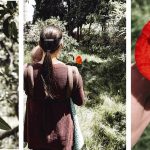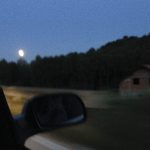STORY BY HEATHER M. SURLS
PHOTOS BY MARY VENDEGNA AND KAMI RICE
Rain spattered the windshield as Austin turned into the Water Wheel Trail parking lot. Driving the two-lane highway here from Payson, we had seen charcoal clouds emitting a fine scrim of rain, but we’d decided to hike even if it were sprinkling when we arrived. In the passenger’s seat, I folded down my striped socks, pulled on my sneakers. We would not be stopped. Not when our boys were overnight with their grandparents for the first time. Not on our first getaway in two years.
I stood in front of the Tonto National Forest sign, its bland brown frame and battered corkboard holding notices about wildlife and flashfloods. Coming from the Middle East, I was used to being fully covered in public spaces. Now the damp air and raindrops whispered over my bare shoulders.
“It says to display your adventure pass in your window,” I told Austin as he strode over carrying a backpack full of water. He wore the wide-brimmed hat we had bought on our way out of the Phoenix Valley to replace the frayed one that predated our marriage of 16 years.
“But,” I continued, wrinkling my nose to nudge up my glasses, “I think the place to buy them was back there.” I tipped my head back so I could see Austin beneath my hat brim.
“Ah, it’s okay,” he replied, batting his hands dismissively. We wouldn’t be stopped, not even by the U.S. Forest Service. Not today, when we wanted to enjoy Arizona. And not this summer, when I have determined to like this state.
The reason for my determination?
I hate Arizona.

I have a permanent mailing address in Chandler and an Arizona state driver’s license. But for years, the most I’ve able to say about this state is, “It’s so hot, I hate it.” My preteen, swiping his blond hair out of his eyes, has asked me, incredulously, “Mom, is that the only reason you don’t like Arizona—because it’s hot?”
The mailing address decision was pragmatic. When our family moved to Jordan in 2015, we chose Arizona over our home state of California because Austin’s parents had moved there and our bank had branches in the Phoenix area. We’ve never resided in Arizona, though, just visited for a week or two every other year when Austin’s on summer break from his job as a professor in Amman.
But my grievances against Arizona also predate 2015. In 2001, my mom, siblings, and I were visiting friends in Mesa when we received bad news: Another friend’s dad—an aerial photographer—had died in a fighter jet crash. We left Arizona immediately, driving eight hours home across the desert to comfort our friends.
In 2009, when Austin and I were still newlyweds, I inexplicably fainted in the bathroom at my in-laws’ house. I opened my eyes to see an overturned plastic trash bin rocking side to side on the tile floor. This was the day before we were supposed to move to Jerusalem for Austin’s master’s program. He had to push me through the airport in a wheelchair.
In 2016, we visited Arizona after our first year and a half in Jordan. In our usual bedroom, with the lumpy polyester comforter pilled with lint and the beach towel thumbtacked over the window, I couldn’t sleep. I’d already been struggling with anxiety in the Middle East; now I found myself startling when the AC kicked on, disturbed by the fan’s arrhythmic clicking. I moved to the living room couch with a bottle of lavender essential oils. While not sleeping, I watched car headlights chase away shadows through the slats of blinds.
Eventually, I was diagnosed with post-traumatic stress disorder, the result of an unexpected physical assault stacked on top of accumulated years of stress. Though I slowly healed from the insomnia that accompanied PTSD, I still could not sleep in my in-laws’ guestroom during visits to Chandler in 2017, 2019, and 2022. Once my father-in-law had locked the door after his nightly scorpion hunt, I’d say goodnight to Austin and then fall asleep on the pull-out couch bed to the sound of my in-laws watching America’s Got Talent or The Amazing Race or the latest bigfoot show in the next room.
Of course, there were good things folded into it all. A trip to the Grand Canyon. Frozen yogurt bars. Swimming. My nieces and nephew. A delightful riot of a plant called the Pride of Barbados. But always this cloak of suspicion, always holding the state at an emotional arm’s length. I felt isolated in Arizona, imprisoned by the sinister heat and our lack of a car and friends. I hated the artificial feeling of the Phoenix valley: the enormous shopping centers and commercialism, the sense that no one would choose to live here if not for air conditioning, electricity, and technology.
At night I walked the cookie-cutter neighborhood, everyone’s yards manicured with cacti and rocks. While the asphalt belched up the day’s heat, I dodged crickets and roaches on the sidewalk. My hands puffed, tightening my wedding ring like a vice. At home, I gulped down cold water.
And yet there were these things too:
The boys splashing & shrieking with Austin in the pool
Mourning doves & mockingbirds
Little planes puttering above the Chandler Airport

Clearly, rain had fallen recently on the Water Wheel Trail. The East Verde River was churned brown like cocoa, the trail muddy in places, with patches of grass slicked down by loose debris. Austin and I walked between oak scrub and sprawling manzanita bushes with smooth red branches. Pale-barked sycamores grew rooted near the riverbanks, alongside a type of pine I couldn’t identify—all these welcome alternates to Phoenix’s drought tolerant mesquites and tamarisks.
“I need an Arizona field guide,” I threw back to Austin, thinking of the one I bring on all trips in Jordan. I hate not knowing the proper names of plants. Here was a deep coral flower, trumpet-like, growing on a low bush. There an eight-foot spire with Cheetos-colored blooms. We were walking in the seam of two biomes, I felt, wild blackberry vines and ferns mingled with paddle cacti. The rain picked up a bit, softly pattering in the muddy river.
“Should we turn around?” Austin called.
I was thrumming with the open space, the delicious feel of rain-chilled wind on my limbs, my literal heart pumping from careful climbs over wet rocks and a twinge of nervousness at the rushing water below. I didn’t want to turn back yet, not today. Not today when I’d decided to love Arizona’s particularities:
The smell of cow patties & wet sediment underfoot
Scrambling over slate- & salmon-colored boulders
A skull-faced cow on the opposite river bank

Before we arrived in Arizona this summer, I decided not to complain. I would shut down my negativity and choose gratitude. Not that I hadn’t practiced thankfulness before—that’s how I journal on long trips to the U.S., making lists of gifts and graces—but I did notice that even a bit of complaining acted as poison, interfering with my ability to recognize goodness.
Driving to Payson before our rainy hike, something shifted. After more than a week in the Phoenix Valley, Austin and I drove northeast, alone, toward the mountains. Here, away from the urban sprawl and noxious heat, the Sonoran Desert is flat and quiet, rimmed by mountains. Soon enough we began to rise in elevation. I sat quietly, cross-legged in the passenger seat with a mug of chai between my hands, observing.
“Just take away the green and it could be Jordan,” Austin commented. He was right—the deserts east and south of Amman are much barer than what we were seeing. Which posed the question: How could I simultaneously love that Jordanian desert—more stark and dry than this—and speak of Arizona with loathing?
Maybe it was habit. Maybe because I’d chosen Jordan, I had found ways to appreciate its rugged aspects. Some of my love for Jordan had been cultivated—it didn’t just drop into me full-grown, but took investment to develop. I wondered if, with intention and attention, I could love this desert too.
Maybe I didn’t have to like every corner of this state. (Could I exclude Phoenix?) But at least I could cultivate some positive emotion toward this place that I had no choice but to return to year after year. I wanted my psyche to rest—to not annually brace itself against the perceived onslaught of heat and artifice. And I was curious: What was I missing by repeatedly barring my consciousness with complaints and generalizations about these 113,623 square miles of earth?
Later that morning, in an antique shop packed with handwoven rugs and baskets, kachina dolls and wagon wheels and cow hides and turquoise-and-silver jewelry, I thought of my great-grandfather, an animator and artist who met my great-grandmother in Arizona. He loved the Southwest and its people, even produced a short film about Indigenous culture in 1962. Maybe some of his love for this region trickled in me yet, if I could just siphon it to the surface.

Photo by Kami Rice
On either side of the highway, iconic saguaro began to appear—first in ones and twos like telephone poles, then in swaths like strange, leafless forests. I read a picture book about them once in the Phoenix Children’s Museum—about how they can survive for up to two hundred years, providing refuge for desert creatures. Driving to Payson, they reminded me of camels, the way they store water in their accordion pleats.
I watched the saguaro flash by, some like straight sentries, others like graceful dancers with arms outthrown, still others like survivors with beaten but resilient limbs. They all wore abundant crowns of fruit—the ripe ones burst open to reveal deep red pulp—and I imagined how regal these cacti must have looked last month, their flowers making the desert bloom with circlets of creamy white.
“If we lived here long enough,” I told Austin, “I’d write about saguaros.”
That evening, after our short hike in the rain, Austin and I sat in our cabin on a Payson cul-de-sac. We ate flatbread with goat cheese and cucumbers. We asked deep questions of one another and let long silences be—abiding in the quiet, contemplative space usually filled with kid noise. Living far from our family networks, we rarely enjoy this many hours one-on-one.
Maybe loving a place is like loving a person: It takes time and intentionality, commitment, faithfulness. It requires opening oneself to receive whatever comes from the other. A willingness to try. A willingness to fail and try again.
Twinkle lights on an A-frame cabin
Vanilla pine shedding bark like a puzzle
Lizard with a lick of blue belly

Late the next morning, Horton’s Creek lay on our right as we climbed a path outside of Payson. Our app said the trail was four miles up with more than 2,000 feet of elevation change. We decided to hike as far as we could in two hours, then turn around.
I’d felt reflective since waking up, emptied of words by the previous day’s conversations and the writing I’d done—the first new piece I’d started since finishing my book in April. As Austin and I hiked, though, endorphins loosed my words. Before long, I was soaring ahead of him, a long stream of words dancing behind me, faster than Horton’s creek: ideas for how to spend my time in the fall when our younger son starts kindergarten and descriptions of all the articles I hope to write in the next academic year and thoughts on returning to Arabic study three hours a week and opinions on the Middle East conflict. We looked at the straight, tall pine trees and laughed about their Jordanian counterparts, how they inevitably grow crooked.
After two hours, we turned around, goaded by a grumbling cumulonimbus cloud, drawn by the Mexican food on which we planned to lunch: bottomless tortilla chips and salsa in stone crockery and fat burritos drowning in red sauce beside bubbling pools of refried beans. Rain began to patter the minute we reached the parking lot. In the car, Austin elevated his feet on the dashboard, and I peeled off my socks in the backseat. My mind was singing Arizona. For hours I’d been alert to the details around me without a notebook or phone to record them. Now I tried to list our hike in as much particularity I could:
Bee balm, wild grape & lupine
Blue motoring dragonflies
Clouds of butterflies: swallowtail, orange & black, lemon yellow
Ice clunking in my water bottle
Dry cinnamon biscuits
Creek below, wind above
As I tapped my phone screen, I felt something deeper than the impulse to describe the mountainside I’d experienced. I felt awake to that place—Arizona—warmer and more open-hearted than I ever had. Willing to love it, willing to try.
Perhaps, rather than manufacturing insincere feelings toward the city of my mailing address, I could start by appreciating these gorgeous pockets of wilderness beyond it. If I developed positive associations with outwardly beautiful places, maybe these associations would accrue like interest, expanding my capacity for gratitude and delight. Maybe they’d mellow my one-sided rhetoric about Arizona into something more nuanced.
Maybe this was just the beginning.



















